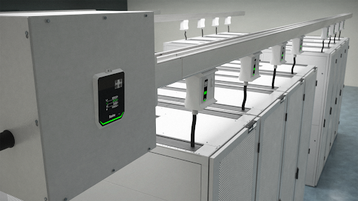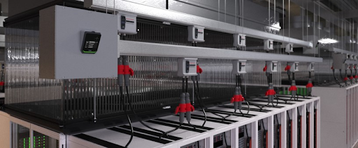The data center landscape is experiencing a seismic shift driven by the exponential growth of artificial intelligence (AI).
As the prevalence of AI technologies continues to rise, providing power distribution to meet the demand for high-performance computing and advanced data processing capabilities becomes a growing challenge.
A recent International Energy Agency report forecasts that data center’s total electricity consumption could double by 2026, reaching more than 1,000 terawatt-hours (TWh) in 2026.
As AI algorithms become more advanced and workloads increasingly dynamic, power requirements can exceed 40kW, potentially straining equipment. However, traditional power distribution systems often fail to meet these facilities' changing needs.
Operational and power design challenges
The increasing power density of AI systems also has implications for data center design and operations. As power distribution systems expand to accommodate higher ampacities, data centers' physical footprints may need to increase. This presents challenges in terms of building design, floor space utilization, and operational logistics.
Additionally, the shift to higher power densities poses operational challenges, such as the need for more frequent maintenance and the potential for increased temperatures in the data center environment.
Common power distribution challenges include:
- Rising power density: Increasing demands on IT infrastructure require higher power densities, leading to complex wiring setups that hinder airflow and efficiency.
- Installation complexity: Traditional systems often involve intricate installation processes, leading to delays and increased labor costs.
- Lack of design flexibility: The ability to adapt to changing power requirements and scale operations is paramount, but rigid power distribution systems can make this challenging.
- Power quality fluctuations: Lack of visibility into harmonic currents and voltages in power systems can lead to efficiency issues, overheating, and safety hazards.
Sustainability challenges
Data centers must also grapple with the dual challenge of accommodating growth and increased energy consumption while prioritizing sustainability and energy efficiency. Regulatory bodies like the European Union (EU) closely monitor data center energy usage through the Energy Efficiency Directive. This directive mandates that data center operators with a total rated power of 500 kilowatts or above are required to publicly report their energy performance data annually.
An integral aspect of sustainability involves addressing 'Scope 3 emissions' under the Greenhouse Gas Protocol. While there’s a significant focus on Scope 1 and 2 responsibilities, which measure emissions from a data center’s own operations and electricity usage, Scope 3 emissions encompass the broader environmental impact of indirect emissions generated by data center operations outside its premises.
To effectively navigate these challenges, data center infrastructure and strategies must adapt to ensure continued reliability, efficiency, and environmental responsibility.
Track busway systems
Data center managers must consider upgrading power systems and integrating power monitoring points to address these challenges. This strategic approach can optimize power and cooling systems, enhancing operational efficiency, particularly as machine learning (ML) integration becomes more prevalent.
Track busway systems offer several advantages over traditional power systems. Suspended or mounted track busways negate the necessity for a remote power panel (RPP) in data centers or pipe and wire electrical distribution in other facilities.
This eliminates the need for extensive wiring setups, resulting in enhanced flexibility and scalability for electrical reconfiguration, and optimizes airflow and energy efficiency, improving the overall sustainability of the data center ecosystem.
Implementing a busway solution that monitors power at various points along the busway is pivotal for ensuring a dependable and secure power distribution system. This approach furnishes real-time voltage, current, and power data for analysis, enabling the identification of potential enhancements in energy efficiency and reliability.
Accurate and reliable data empowers data center managers to make informed decisions, resulting in effective strategies that optimize operations, yield significant cost savings, and enhance overall performance.
Track busway qualities to look for
Data center managers should consider selecting track busways that offer the following features:
- Flexibility and scalability: A continuous access slot design that allows self-contained plug-in units to be positioned at any point along the busway, offering high plug-in unit density, and allowing for seamless expansion and adaptation to changing power requirements.
- Real-time power monitoring: Advanced energy metering capabilities for branch circuit and end feed monitoring. This empowers data center operators to make informed decisions to enhance energy efficiency and report on energy usage.
- Ease of installation and maintenance: Plug-in-units that can be easily and quickly added, removed, or relocated that require no routine maintenance.
- Customization: Flexible design to offer customizable lengths, sizes, colors, and configurations to meet your unique specifications.
- Service offering: Look for a supplier that offers a range of ancillary services, including on-site support, recertification, and extended warranty plans to safeguard your investment, reduce risk, and minimize downtime.
- Product transparency: Partner with a sustainable supplier that can provide Product Environmental Profiles (PEPs) that communicate the environmental impact and performance of the product based on Life Cycle Assessment (LCA).
Embracing the future
The rise of AI technologies presents challenges and opportunities for the data center industry. By incorporating track busway solutions into data center infrastructure, operators can address the challenges posed by escalating power densities while contributing to significantly reducing Scope 3 emissions. This will position data centers to meet the demands of AI-driven workloads while ensuring their facilities’ continued reliability and energy efficiency.
Starline track busway offers an innovative solution for powering high-density deployments and adapting to the evolving needs of AI-driven workloads. Its first-of-its-kind access slot allows for flexible layout changes without service interruption, reducing electrical installation time by 90 percent.
Additionally, the Starline Critical Power Monitor can mitigate the operational risks of power surges and harmonic distortion. Product Environmental Profiles (PEPs) are also available for all T3 and T5 track busway systems. By leveraging these technologies, data center operators can position themselves for success in the AI-driven future.
To learn more about how Legrand can prepare your business for AI, click here.
More from Legrand
-

Legrand acquires Kiwi cable management firm MSS
New addition to help company target data centers
-

Sponsored Leveraging power quality intelligence to drive data center sustainability
How choosing the right PDU can enhance reaching your data center's performance goals
-

Sponsored Enhancing data center energy efficiency: Six critical airflow management measures
Airflow management and optimization are critical to any such data center energy efficiency improvement project



